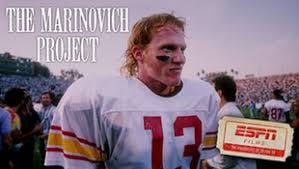The Marinovich Project, initiated by former NFL quarterback coach Marv Marinovich, was an ambitious attempt to create the perfect athlete through meticulous planning and control. Beginning in the late 1980’s, the project gained widespread attention for its unconventional and often controversial methods, all focused on sculpting Marv’s son, Todd Marinovich, into an elite quarterback.
The Philosophy Behind the Marinovich Project
Marv, a former strength and conditioning coach for the Oakland Raiders, firmly believed that by managing every aspect of his son's life—including diet, exercise, and mental conditioning—he could mold him into a superior athlete. From birth, Todd’s environment was carefully engineered to optimize both his physical and mental development for football success.
A key principle of the Marinovich Project was the complete elimination of anything deemed detrimental to athletic performance. Todd was raised without processed foods, refined sugars, or typical childhood indulgences. However, this extreme control extended far beyond diet—it also restricted social experiences such as vacations and friendships, ensuring that Todd's life revolved solely around football preparation.
The Rigorous Training Regimen
Todd's training began as soon as he could walk. Unlike traditional athletic development, his regimen prioritized flexibility, coordination, and movement efficiency from infancy. Daily stretching routines and balance drills were staples of his early years, with Marv believing that superior mobility and body control were the foundations of elite performance.
As Todd grew older, his training became increasingly intense. His regimen included:
Agility and Footwork: Daily cone drills, ladder footwork, and reaction-based movement exercises to develop quickness and explosiveness.
Strength and Power: Marv rejected traditional weightlifting, favoring resistance bands, medicine balls, and isometric holds to build functional strength without excessive bulk.
Speed and Endurance: Barefoot sand running, resisted sprinting with bands, sled drags, and uphill runs to enhance speed and stamina.
Mental and Physical Toughness: Long, grueling stamina-based drills, such as stair running, wind sprints, and stadium runs, designed to ensure Todd never reached a point where exhaustion dictated his performance.
Nothing in Todd’s training was left to chance. Every drill, movement, and session had a purpose—to create an athlete who moved better, reacted faster, and performed longer than anyone else on the field.
The Cost of Perfection
While the Marinovich Project produced a supremely gifted athlete, it also had significant drawbacks. The relentless physical demands and rigid structure came at a mental and emotional cost. The very methods that built Todd’s elite physical ability also led to burnout, rebellion, and ultimately, struggles with substance abuse and legal issues.
The project serves as a cautionary tale about the risks of extreme training methodologies. While Todd excelled in high school and at USC, the intense pressure from his father led to a loss of personal autonomy, stripping away the joy and spontaneity that often sustain long-term athletic success.
Lessons from the Marinovich Project
The story of Todd Marinovich underscores several critical lessons in athletic development:
Balance is Key: While intense training can yield short-term success, extreme specialization and control often lead to burnout and rebellion.
Holistic Development Matters: Physical training must be paired with psychological and emotional well-being. A rigid, one-dimensional approach can hinder an athlete's long-term potential.
Parental Influence Should Guide, Not Dictate: Support and encouragement are essential, but excessive control and unrealistic expectations can have detrimental consequences. Athletes need autonomy to develop a sustainable passion for their sport.
It seems obvious, but balancing the instinct to push athletes to their limits while allowing them to enjoy the game is vital for fostering long-term success. The best way to help athletes reach their peak performance isn’t just relentless training—it’s keeping them in a state of eagerness and hunger to improve. Motivation and love for the game are far more powerful tools than an overwhelming workload alone.
John


